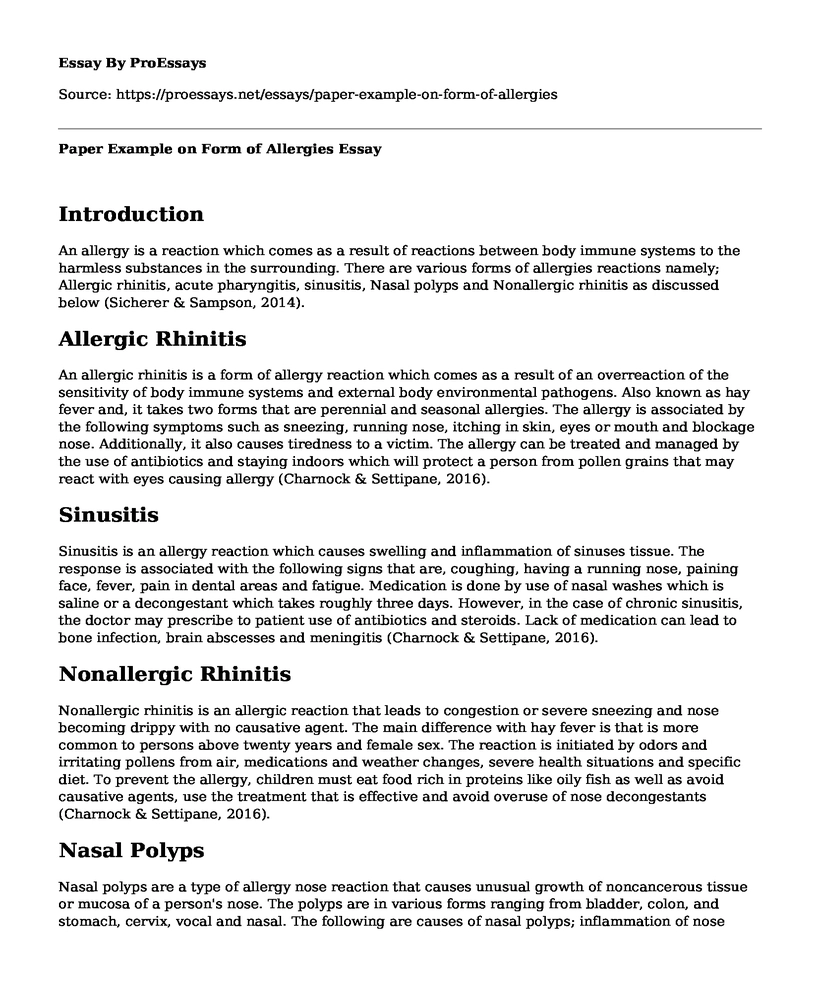Introduction
An allergy is a reaction which comes as a result of reactions between body immune systems to the harmless substances in the surrounding. There are various forms of allergies reactions namely; Allergic rhinitis, acute pharyngitis, sinusitis, Nasal polyps and Nonallergic rhinitis as discussed below (Sicherer & Sampson, 2014).
Allergic Rhinitis
An allergic rhinitis is a form of allergy reaction which comes as a result of an overreaction of the sensitivity of body immune systems and external body environmental pathogens. Also known as hay fever and, it takes two forms that are perennial and seasonal allergies. The allergy is associated by the following symptoms such as sneezing, running nose, itching in skin, eyes or mouth and blockage nose. Additionally, it also causes tiredness to a victim. The allergy can be treated and managed by the use of antibiotics and staying indoors which will protect a person from pollen grains that may react with eyes causing allergy (Charnock & Settipane, 2016).
Sinusitis
Sinusitis is an allergy reaction which causes swelling and inflammation of sinuses tissue. The response is associated with the following signs that are, coughing, having a running nose, paining face, fever, pain in dental areas and fatigue. Medication is done by use of nasal washes which is saline or a decongestant which takes roughly three days. However, in the case of chronic sinusitis, the doctor may prescribe to patient use of antibiotics and steroids. Lack of medication can lead to bone infection, brain abscesses and meningitis (Charnock & Settipane, 2016).
Nonallergic Rhinitis
Nonallergic rhinitis is an allergic reaction that leads to congestion or severe sneezing and nose becoming drippy with no causative agent. The main difference with hay fever is that is more common to persons above twenty years and female sex. The reaction is initiated by odors and irritating pollens from air, medications and weather changes, severe health situations and specific diet. To prevent the allergy, children must eat food rich in proteins like oily fish as well as avoid causative agents, use the treatment that is effective and avoid overuse of nose decongestants (Charnock & Settipane, 2016).
Nasal Polyps
Nasal polyps are a type of allergy nose reaction that causes unusual growth of noncancerous tissue or mucosa of a person's nose. The polyps are in various forms ranging from bladder, colon, and stomach, cervix, vocal and nasal. The following are causes of nasal polyps; inflammation of nose tissue and foreign antigens objects such as pollen grains. People who are suffering from asthma, exposed to allergies, have a high sensitivity to aspirin and have sinus infections have high chances of contacting nasal polyps. The diagnosis is made after the doctor has identified the affected areas. The doctor may prescribe the use of nasal steroids or corticosteroids medication. However, severe cases may require surgical operations. Other preventions include exercising, abstinence from tobacco; a balanced diet and minimizing alcohol take (Kaplan, 2014).
Acute Pharyngitis
Acute pharyngitis is an allergy reaction which causes blockage of the throat that makes swallowing of liquids and substantial very painful. The condition also may result due to friction leading to throat scratching resulting in a sore throat. The complication is caused by bacterial and viral agents such as common cold and whooping cough. The viral causative causes mononucleosis and influenza. The treatment for bacterial infection is the use of antibiotics, however; one can apply home remedies such as eating warm diet, drinking a lot of fluids and gaggling hot saline water (Kaplan, 2014).
Conclusion
In conclusion, various forms of allergy requires different treatments based on causative agents.
References
Charnock, D. R., & Settipane, R. A. (2016). Epidemiology of rhinitis: allergic and nonallergic. In Nonallergic Rhinitis (pp. 45-56). CRC Press.
Kaplan, A. (2014). Canadian guidelines for acute bacterial rhinosinusitis: clinical summary. Canadian Family Physician, 60(3), 227-234.
Sicherer, S. H., & Sampson, H. A. (2014). Food allergy: epidemiology, pathogenesis, diagnosis, and treatment. Journal of Allergy and Clinical Immunology, 133(2), 291-307.
Cite this page
Paper Example on Form of Allergies. (2022, Aug 10). Retrieved from https://proessays.net/essays/paper-example-on-form-of-allergies
If you are the original author of this essay and no longer wish to have it published on the ProEssays website, please click below to request its removal:
- Abortion: Ethical Theories and Principles Essay
- Paper Example on Non-Profits: Working on Grounds of Charity?
- Compare and Contrast Essay on E-Cigarettes vs Traditional Smoking: Health Concerns & Benefits
- Research Paper on Obesity: A Global Crisis Affecting Millions of Lives
- Research Paper on Type II Diabetes: A Growing Health Crisis in America
- Free Essay Example on Getting Back on Your Feet: Post-Illness Advice from a Patient
- Nurse Self-Growth: Achieving the Best Self for Quality Care - Essay Sample







